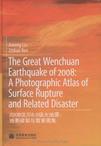2008汶川8.0级大地震
2009-9
高等教育出版社
吴振峰.
120
160000
The magnitude Ms 8.0 (Mw 7.9) Wenchuan earthquake occurred on 12 May 2008 in the LongmenShan region of China——the topographical boundary between the Tibetan Plateau and the SichuanBasin——resulting in extensive damage throughout central and western China. To understand theseismic faulting mechanism and surface deformation features associated with the Wenchuanearthquake, including rupture length, geometric characteristics, and slip distribution of co-seismicsurface rupture, our survey group traveled to the epicentral area 2 days after the earthquake andundertook 10 days of fieldwork, during which time we collected fundamental data related torupture structures and the spatial distribution of offset along faults. Based on the results of thispreliminary fieldwork, we carried out additional detailed fieldwork along the co-seismic surfacerupture over the following year.This photographic atlas shows the main deformation characteristics of co-seismic surfacerupture and the nature of the earthquake disaster and subsequent relief operations, based onphotographs taken during our field investigations. This atlas is intended not only for geologists,seismologists, and engineers as a means of furthering their understanding of the seismicmechanisms and surface rupture deformation characteristics of large intracontinental earthquakes,but also for advanced undergraduates and graduate students as a textbook.We are grateful to the many organizations and individuals who helped to make this bookpossible. Thanks are also due to Professor Dong Jia and Dr. Xiaojun Wu of the NanjingUniversity for their assistance in the field.
The Great Wenchuan Earthquake of 2008S: A Photographic Atlas ofSurface Rupture and Related Disaster focuses on the main deformationcharacteristics of co-seismic surface rupture, including rupture length andslip distribution of co-seismic surface rupture caused by the WenchuanEarthquake and its associated relief operation. The magnitude Ms 8.0(Mw 7-9) Wenchuan Earthquake occurred on 12 May 2008 in the LongmenShah region of China, the topographical boundary between the TibetanPlateau and the Sichuan Basin, resulting in extensive damage throughoutcentral and western China. This atlas contains distinct photographs obtainedduring the field investigation carried out immediately 2 days after thequake. The atlas is designed for geologists, seismologists and architectureengineers engaged in seismic mechanisms and surface rupture deformationcharacteristics of large intracontinental earthquakes.
Dr. Aiming Lin is Professor at Shizuoka University, Japan.
1. Tectonic Setting of the Wenchuan Earthquake2. Outline of Earthquake and Focal Mechanisms3. Outline of Co-seismic Surface Rupture 3.1 Distribution of co-seismic surface rupture 3.2 Slip distribution of co-seismic fault4. Deformation Characteristics of Co-seismic Surface Rupture 4.1 Co-seismic fault scarp 4.2 Co-seismic flexure-slip fold structure5. Relationship Between Surface Rupture and Pre-existing Active Faults6. Relationship Between Surface Rupture and Damage to Infrastructure7. Co-seismic Landsliding and Liquefaction8. Earthquake Disaster9. Relief OperationsReferencesIndex of Figures
插图:3.1 Distribution of co-seismic surface ruptureField investigations reveal that the Ms 8.0 Wenchuan earthquake of 12 May 2008 produced a 285-kin-long surface rupture zone along the Longmen Shan Thrust Belt, eastern margin of the TibetanPlateau, mainly along the pre-existing Yingxiu-Beichuan, Guanxian-Anxian, and Qingchuanfaults, which are three of the main active faults within the thrust belt.These faults define a left-stepping en echelon pattern with-10 km clearance. Co-seismic surface ruptures concentratedwithin a zone of < 50 m in width (generally < 20 m), largely following the strike of pre-existingfault traces within the thrust belt. Based on the geometry and distribution of deformation structures, the Wenchuan rupture zonecan be divided into the northem, central, and southem segments. The northern segment, restricted tothe fault trace of the Qingchuan Fault, extends for -50 km, terminating at the town of Shazhou in thenortheast, near the border between the Sichuan and Gansu provinces. The central segment, -105 km inlength, occurs along the northeastern segment of the Yingxiu-Beichuan Fault. The southem segment,-130 km in length, branches into two parallel sub-rupture zones: one along the southwestern segmentof the Yingxiu-Beichuan Fault between the towns of Beichuan and Yingxiu, terminating to thesouth of Yingxiu town, and another along the Guanxian-Anxian Fault (which forms the topographicboundary between the Longmen Shan Range and the Sichuan Basin), terminating to the south ofDujiangyan City near the epicentral area of the Wenchuan earthquake.Field investigations demonstrate that (i) the Wenchuan earthquake occurred upon pre-existingactive faults of the Longmen Shan Thrust Belt; (ii) the long rupture length and large thrustingslip resulted from compressive stress associated with eastward extrusion of the Tibet Plateau asit accommodates the ongoing penetration of the Indian Plate into the Eurasian Plate; and (iii)present-day shortening strain upon the eastern margin of the Tibetan Plateau is mostly released byseismic slip along thrust faults within the Longmen Shan Thrust Belt.
《2008汶川8.0级大地震:地表破裂与震害图集(英文版)》由高等教育出版社出版。
